KEY FINDINGS
Brief 2: 4.15.20
FINDING 1
In general, Americans feel more informed, more hopeful and less worried than last week.
Overall this week, Americans were more likely to say they have “the right amount of information” about most categories, including when people need to quarantine (up 7% from week 1), how long to quarantine (up 6%), the current number of cases near them (up 6%), a respondent’s risk of getting COVID-19 (up 6%), how to prevent getting the virus (up 5%), and more.
And since week 1, feelings of hope and relaxation significantly increased: In the past week, 43 percent of respondents reported feeling hopeful, compared to 38 percent in week 1; a third (33%) reported feeling relaxed, compared to 29 percent the previous week. However, a third of Americans still report feeling anxious (35%) or tired (33%).
This week, the same worries predominate all Americans: the economy, the health of medical and other frontline workers, and people not taking COVID-19 seriously. However, despite slightly more people now knowing someone who has/had COVID-19 (up from 24% to 28%), Americans overall are significantly less worried this week than they were last week.
- The economy: 69% week 1; 65% week 2
- The health of medical/frontline workers: 68% week 1; 64% week 2
- People not taking COVID-19 seriously: 66% week 1; 60% week 2
- The health of friends or family members: 53% week 1; 46% week 2
FINDING 2
The COVID-19 pandemic is having a significant impact on families.
The vast majority (81%) of Americans say they have been financially impacted at least a little by COVID-19 as of the second week of April 2020, and nearly one in four have experienced a very large financial impact. For family households, the impact is even greater: Nearly nine in ten (87%) respondents with kids under 18 in the household report a financial impact, compared to 77 percent of those without kids in the home. And nearly a third (28%) of respondents with family households report a large financial impact, compared to 21 percent of those without kids.

Parents much more affected financially
Parents report needing much more help than those without kids in the household. This holds true for both child and family-related categories like keeping the family entertained and engaging kids in educational activities—and in a general sense. For example, four in 10 parents (42%) report needing PPE like masks and/or gloves and peace of mind (40%)—compared to 27 percent and 24 percent of non-parents, respectively.
Parents are much more worried in general than people without kids in the household. This is true for the top three concerns of Americans (the health of medical/frontline workers, the economy, and people taking COVID-19 seriously), as well as all other categories, ranging from their financial situation and crime in their communities, to their children’s education and long-term effects of the pandemic on their children.

Parents Need Much More Help
In addition, parents are significantly more likely to feel anxious, tired and irritable than those without kids in the household. All respondents continue to rate gratitude as the top-most feeling, though stark differences can be seen for some of the more troubling or negative emotions.
Social media is a top platform for parents to discuss fun and educational activities for their children during the quarantine. While some parents turn to online sources for advice and tips, others use their social presence to share recommendations. The majority of discussions occur on Twitter or on blogs, with parenting-specific blogs rising to the top. Most importantly, while only 2,200 posts specifically mentioned family activities during the past 30 days, over 15,000 engagements were seen across those posts, speaking to the eagerness of parents to exchange information.

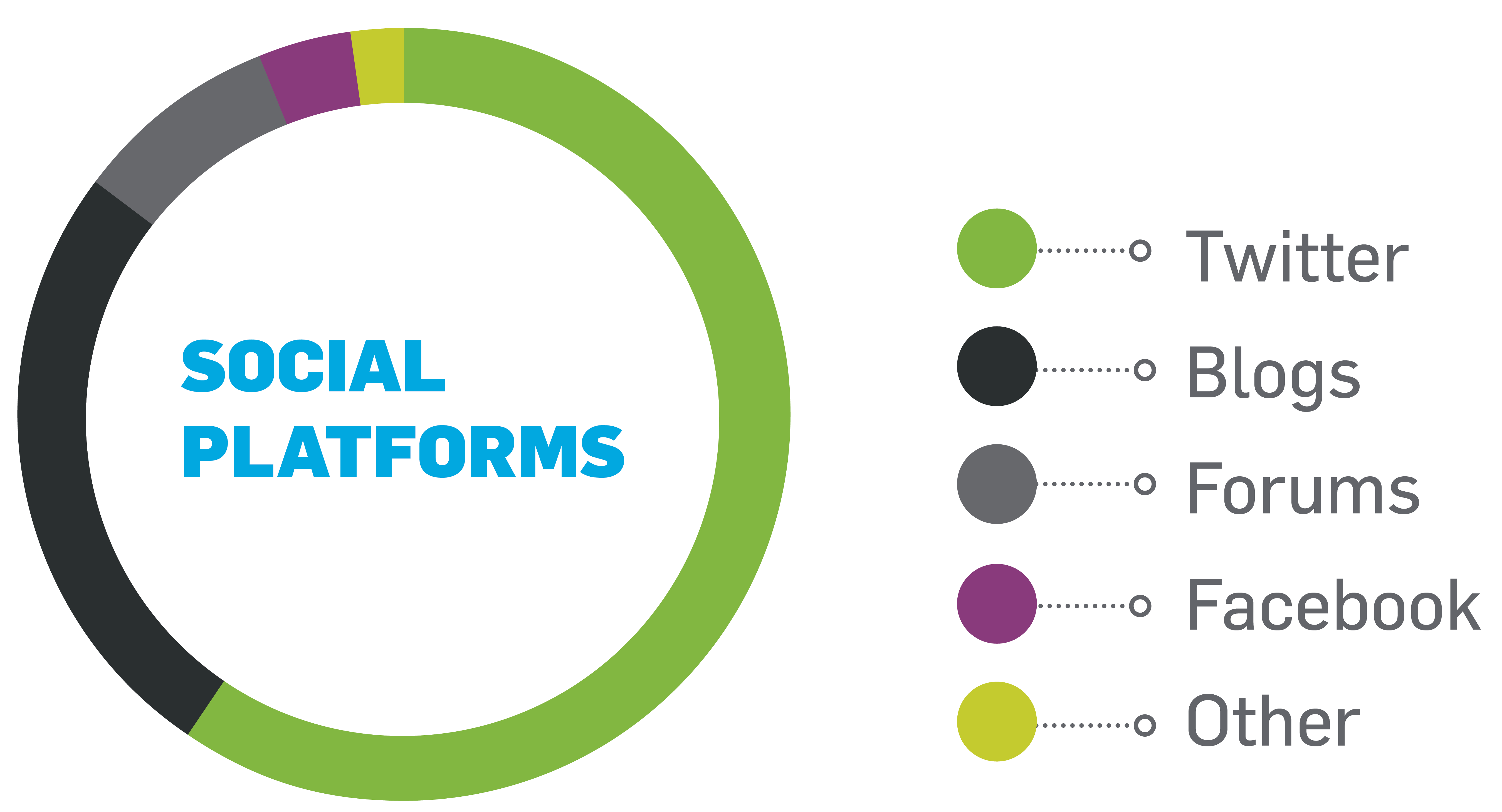

FINDING 3
Younger Americans are the most financially impacted—and the most worried.
Young people ages 18-30 report the most financial impact so far (88%), and nearly one in three of this age group (30%) reports a large financial impact. Only 11 percent of younger Americans report no financial impact to date. In contrast, respondents ages 65+ report the least impact: 68 percent have been financially impacted in some way, with 17 percent reporting a large impact. A third (31%) of Americans ages 65+ have had no financial impact to date.
Younger people also report more immediate needs than those in older age groups. Four in ten respondents ages 18-30 (40%) and 31-44 (41%) report needing peace of mind, compared to 23 percent and 12 percent of those aged 45-64 and 65+, respectively. Getting access to PPE like masks and/or gloves has the least disparity between age groups—though respondents aged 18-44 still ranked higher on all needs compared to respondents aged 45+.
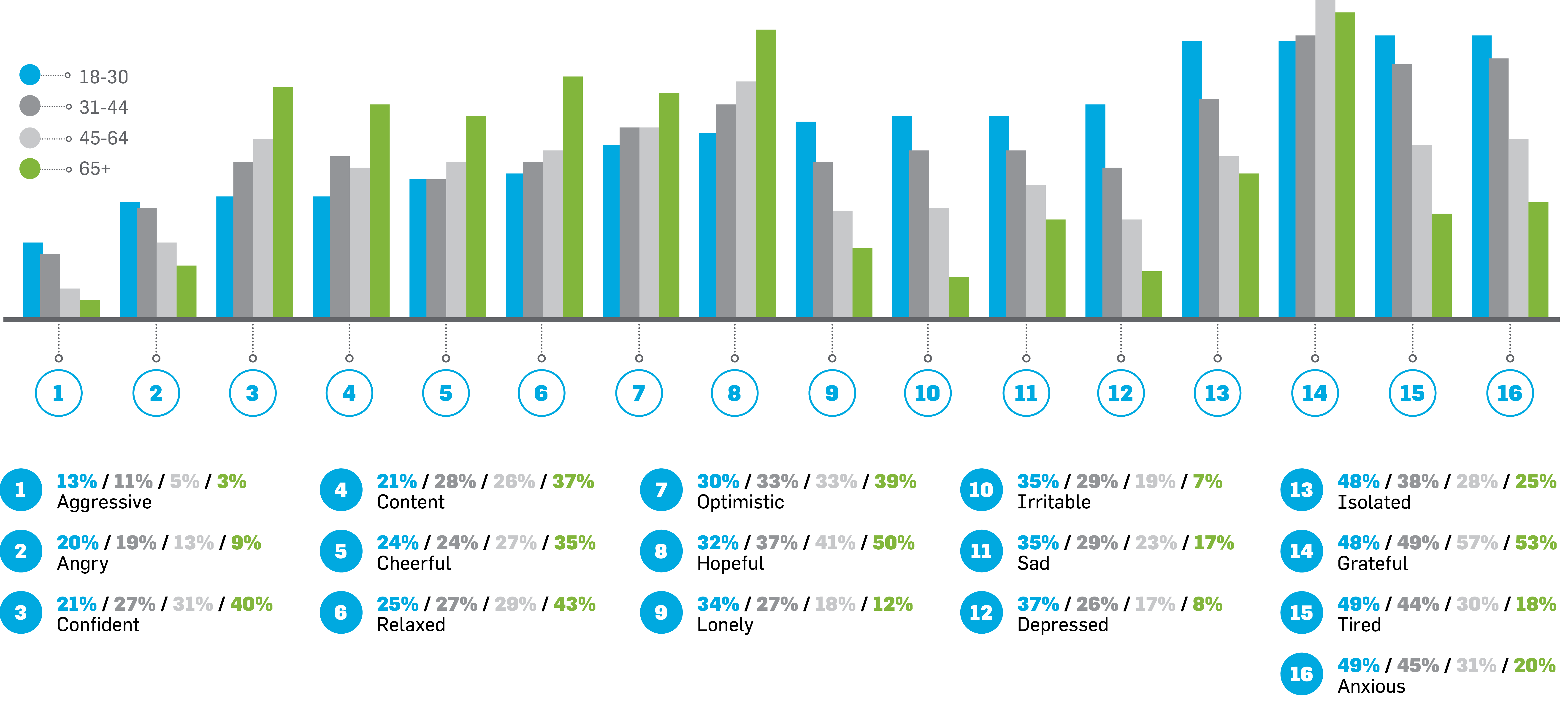
Emotions Vary by Age
Despite the global uncertainties surrounding the pandemic, Americans are still overwhelmingly grateful. In fact, more than half (53%) of respondents report feeling grateful in the past week alone.
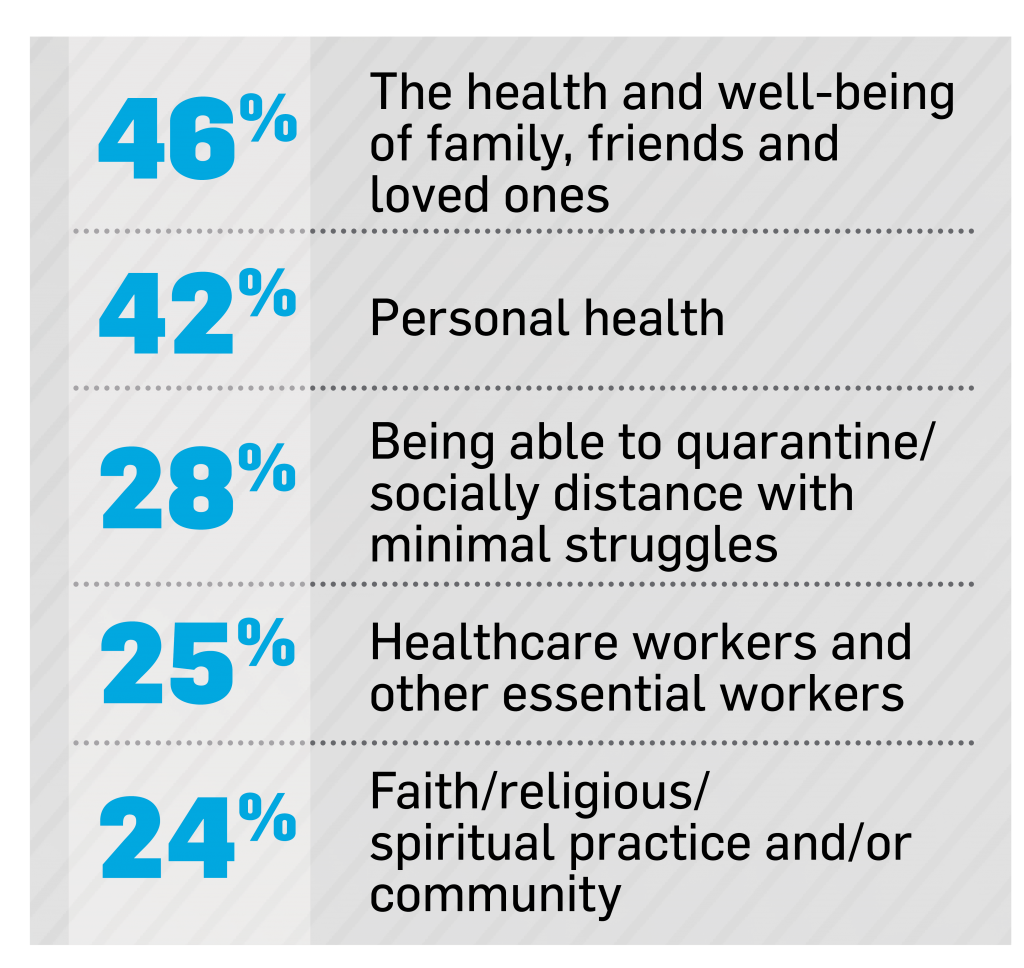
In online conversations, younger generations appear to be struggling most significantly as well. When looking at posts sharing feelings of worry and other negative emotions associated with COVID-19, 94 percent of mentions stem from those ages 18-34. While platform usage and generational habits play a role here as well, their struggle is unquestionable. To add a bit of context, the top emojis used by the 18-34 age group include the loudly crying face, the sad face, the pleading face, the ever-present face with tears of joy, and the upside-down face.
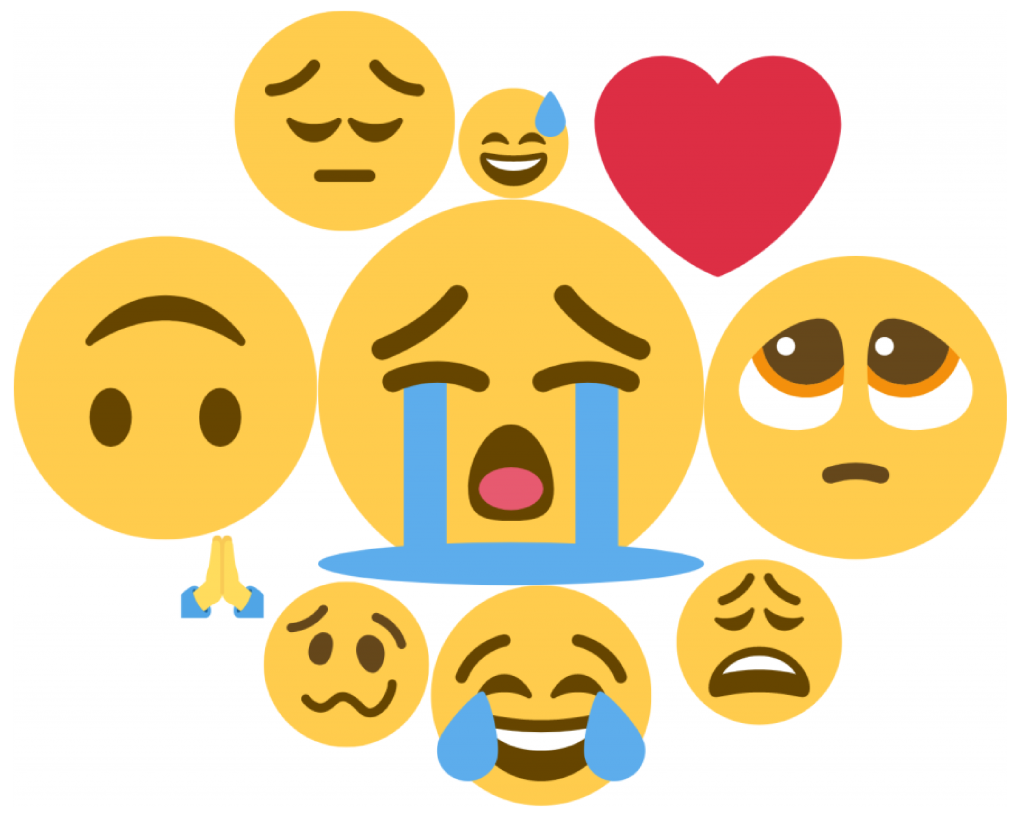
FINDING 4
Lower income Americans have greater needs and more concerns related to COVID-19 than those at higher income levels.
Americans who report an income of $49.9k or less report drastically different needs than those with an income of $100,000+.
Getting PPE like gloves and/or masks and peace of mind still rank as the top two needs for all respondents, but the amount of which items are needed greatly varies by income level. In third behind these two categories, high-income Americans report needing assistance staying active and healthy (23%).
Needs for low-income Americans are greater across the board, and include categories like general financial assistance due to loss of income (31%), affording household bills (31%), food and housing (27% each)—as well as things like loneliness (22%) and mental health support (20%).
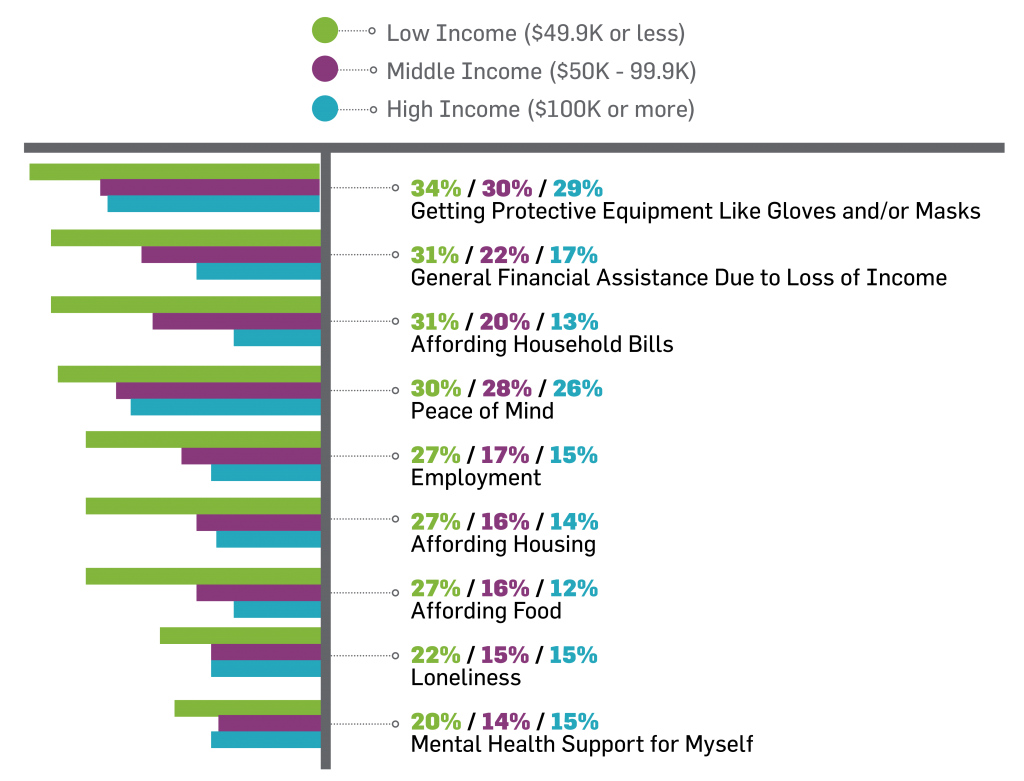
Lower-income Americans are also significantly more tired, lonely and depressed than other respondents. For example, one in four (40%) of low-income respondents report feeling tired in the past week, compared to one in three of those with middle (32%) and high (31%) incomes.
Concerns also vary by income level. Higher-income Americans ($100k+) are more worried about the economy and the health of frontline workers, compared to respondents earning lower incomes. Lower-income Americans ($49.9k or less) are more worried about crime, losing jobs, health, and mental health, the ability to pay bills and more.

Emotions Vary by Income Level
FINDING 5
Northeasterns are the most impacted, the most worried, and the most anxious.
Going into the second week of April 2020, the Northeastern region of the United States continues to be the hardest hit with the highest number of confirmed COVID-19 cases.5 Thirty-nine percent of respondents in the week 2 online survey report knowing someone who has/had COVID-19, up from 38 percent in week 1. The likelihood of knowing someone who has/had the virus also increased slightly for Americans in the Midwest and South, from 23 to 26 percent in the Midwest, and 22 to 24 percent in the South.
However, the Western region saw the biggest jump: In the week 1 survey, fewer than one in five respondents (18%) knew someone who has/had the virus. This grew to nearly three in 10 (28%) in week 2.
Needs also continue to differ by region. The top two concerns of Americans in general are getting PPE like gloves/masks and peace of mind, though these needs are reported by many more Northeastern respondents than those in the Midwest:
- Getting PPE like gloves/masks: 34% Northeast; 25% Midwest
- Peace of mind: 34% Northeast; 24% Midwest
Other discrepancies between these two regions include:
- Keeping up a sense of community: 23% Northeast; 13% Midwest
- Mental health support for members of my household: 19% Northeast; 13% Midwest
- Mental health support for myself: 20% Northeast; 14% Midwest
As the most affected area, the Northeast is more worried about a number of categories, compared to other regions:
- The health of medical/frontline workers (70%)
- The economy (69%)
- The health of friends/family (57%)
As the region most affected by the pandemic thus far, Northeasterners are more worried about the health of medical and other frontline workers (70%) compared to other regions, as well as the health (57%) and mental health (33%) of friends and family. They are the least worried of all regions about a spouse or partner losing his/her job (18%).
As of the week 2 survey, the Northeast is outpacing other regions as the most anxious, tired and isolated—while the South is the most confident, hopeful, optimistic, relaxed and grateful. In general, Americans who live in areas with fewer confirmed cases of COVID-19 feel more positive/content, compared to those who live in areas with the most cases (15,000+).
Three in four Americans say they have sought out information about COVID-19 in the past week. The top news source for nearly half of respondents (47%) was TV news. The next popular news sources were the CDC (37%), online news sources (36%), NIAID Director Dr. Anthony Fauci (32%) and local government sources (28%).
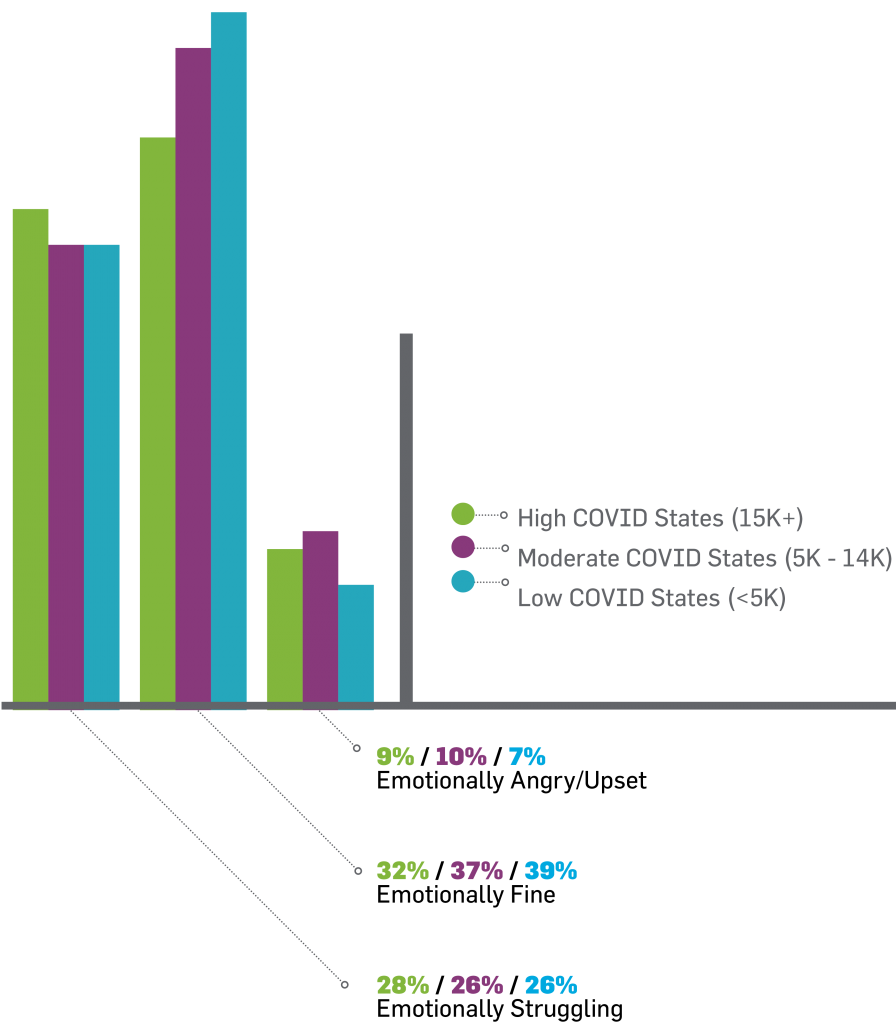
EMOTION vary by state
Conclusion
As the United States nears the peak of the COVID-19 pandemic,6 Americans from every corner of the country are feeling the impact in one way or another.
Certain populations are feeling the effects of the virus more than others. Geographically, the Northeast has been hit the hardest so far—in terms of cases, worries, concerns and more. Younger Americans are also taking a hit compared to older generations, as are parents and lower income Americans.
But in general, Americans are continuing to hold their heads high. Gratitude continues to top the list of emotions they’re feeling, and hopefulness and relaxation are actually growing. Americans are feeling more informed and less worried than just a week ago.
As the pandemic continues, the Ad Council continues to ask: Will Americans’ needs and worries change, and if so, how? Do those who are the most vocal online truly represent the needs of Americans who may not be finding their voices in social conversations? Are the resources and reassurances provided to the American public by leaders (like federal and local governments, issues experts and lead scientists) really meeting the nation’s needs? How can brands, the media, causes and foundations adequately address these needs and support Americans when they need it most?
This is the second weekly research brief from the Ad Council that highlights the top conversations/findings as they evolve during this time.
